�
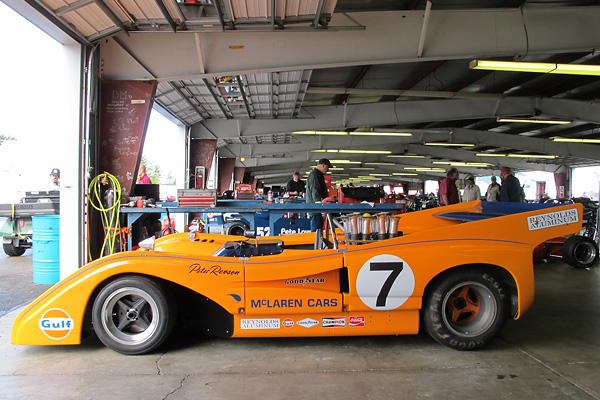
�
�
Scott Hughes' McLaren M8F Can-Am Racecar
� � Owner: Scott Hughes� City: Sunset, South Carolina
� Model: McLaren M8F
� Engine: Chevy big block V8
� Built by: Commander Motor Homes racing team
� Race prepared by: Jack Deren
�
In Tribute
��
Scott Hughes' McLaren M8F is presented here in the familiar livery of the Bruce McLaren Motor�
Racing team, circa 1971. It even bears the name of their championship winning driver, Peter Revson.�
To be perfectly clear, this car was built by the Commander Motor Homes racing team during�
the 1973 Can-Am season. It didn't exist in any form in 1971 when the McLaren team was racing�
their own M8Fs. This article includes the car's actual history, some of the history of the team�
who built it, and for background we'll briefly review the history of the McLaren team's own M8F�
racecars. As always though, BritishRaceCar.com is primarily interested in design and construction�
details. This car provides a largely accurate representation of how McLaren built and prepared�
their original M8F racecars.�
�
Note: this article was originally published on March 12th, 2011. It was updated on�
June 28th, 2011 with period photographs and historical information from former Commander Motor�
Homes team member John Bruce Robles and from McLaren vintage racer and historian Bob Lee.�
I'm very much indebted to these gentlemen for their assistance. -Curtis�
�
�
�
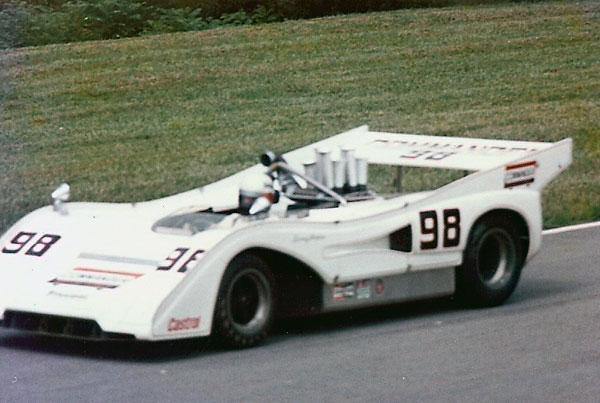
�
Danny Hopkins drove the Commander team's first number 98 McLaren, chassis M8FP 72-09,
�
to a 13th Overall finish in their first race of the 1973 Can-Am season (at Atlanta, July 7th.)
�
The Commander Motor Homes Team
��
Commander Motor Homes owner Mike Slater empowered Charlie Agapiou to launch a formidable�
assault on the Can-Am series. They envisioned a three driver program, and went looking�
for cars. They ultimately procured five McLaren sports cars.�
�
Two of the five sports cars had an especially noteworthy pedigree: they were the cars that Bruce�
McLaren Motor Racing teammates Peter Revson and Denny Hulme had driven to an easy one-two�
finish in the 1971 Can-Am championship. After dominating that season, the McLaren team had sold�
both Peter Revson's championship winning M8F and also Denny Hulme's second place M8F to�
Gregg Young of the Young American Racing Team. During the 1972 season, Francois Cevert drove�
the Revson car through a successful season, ultimately placing fifth in championship points.�
Gregg Young personally drove the Hulme car, until wrecking while racing at Mid-Ohio and then again�
during practice at Edmonton. After the 1972 Can-Am season, Young sold both former McLaren team�
M8Fs to the Commander Motor Homes racing team. Commander painted the Revson car white and�
assigned it number 97. Commander sent the badly damaged Hulme car to John Mason's shop, to be�
extensively rebuilt under the direction of none other than famous race engineer Carroll Smith. �
�
The third car Commander purchased for their program was actually built by a company called�
Trojan under an exclusive license from McLaren. Trojan built nine complete "production"�
McLaren M8FP racecars in 1972. (The M8FP model was simply the production version of the M8F.�
Some of the specific technical differences between the production cars and the original team�
cars are pointed out in photo captions below.) The ninth and final complete Trojan M8FP,�
serial number "72-09", was purchased slightly used from a gentleman named Bill Cuddy. By�
all accounts it was in almost new condition. Originally delivered in baby blue gel coat,�
Commander Motor Homes painted 72-09 white and assigned it number 98.�
�
 �
�
�
�
�
The Commander Motor Homes team built up their fourth McLaren M8F from a spare monocoque tub during�
the 1973 Can-Am season. The tub was provided by Trojan and is nominally an M8FP tub, but it came�
with neither a Trojan nor a McLaren chassis plate or serial number. This McLaren M8F is the main�
subject of our article. After M8FP 72-09 was badly damaged in an accident, this fourth car was�
pressed into service and it assumed racing number 98. �
�
Commander's fifth McLaren sports car was a very different beast: the 1972-model McLaren M20 that�
McLaren team driver Denny Hulme had flipped at Road Atlanta. The negotiations behind this�
purchase could be the subject of an interesting book, but they're outside the scope of our�
article. Suffice it to say that Mike Slater had persuaded Mario Andretti to drive for�
Commander Motor Homes but that the deal hinged on Andretti being provided a really top flight car.�
To be that competitive, Commander would need to master turbocharging.�
�
Mike Slater and Charlie Agapiou initially hoped that they might be able to satisfy Mario Andretti by�
building the ultimate McLaren M8F, with a chassis re-engineered by Carroll Smith and a turbocharged�
big block Chevy engine which would be developed inhouse by their engine guy: Barry Crowe.�
Mario Andretti quickly put a stop to their ultimate M8F plan. The McLaren M20 was a newer design,�
and he would require a state of the art chassis. The Hulme M8F was rebuilt, re-powered, and sold by�
the Commander team without of entering a race during their ownership.�
�
Instead, the ex-Hulme McLaren M20, was purchased with a McLaren-installed turbocharger system�
which was used at Road Atlanta and then abandoned. Commander's Barry�
Crowe would instead develop a unique new system for the Mario Andretti M20.¹�
Unfortunately, Commander's turbocharger development program didn't yield fruit quickly enough.�
Ultimately, the Crowe-developed turbocharged M20 was only driven in the last two events of�
Commander's 1973 Can-Am season, and it didn't complete either race. It wore Commander livery�
and the number 96.�
�
How did this new race team fare? Here's the short version, extracted from the record books:
�
(Note: the long version is more interesting!)�
�
Commander's 1973 Can-Am Season Results
�| #97 | Milt Minter | Road Atlanta | 7/7/1973 | DNF (engine failure) | |
| #97 | Bobby Brown | Watkins Glen | 7/22/1973 | DNF (engine failure) | |
| #97 | Bobby Brown | Mid-Ohio | 8/12/1973 | 5th | |
| #97 | Bobby Brown | Road America | 8/26/1973 | 5th | |
| #97 | Bobby Brown | Edmonton | 9/16/1973 | DNF (blown engine) | |
| #97 | Bobby Brown | Laguna Seca | 10/14/1973 | 4th | |
| #97 | Bobby Brown | Riverside | 10/28/1973 | DNF (broken wheel) | |
| #97 | Bobby Brown | Final point standings | 11th, with 26 points | ||
| #98 | Danny Hopkins | Road Atlanta | 7/7/1973 | 13th | |
| #98 | Danny Hopkins | Watkins Glen | 7/22/1973 | 13th | |
| #98 | Danny Hopkins | Mid-Ohio | 8/12/1973 | 6th | |
| #98 | Danny Hopkins | Road America | 8/26/1973 | 9th | |
| #98 | Danny Hopkins | Edmonton | 9/16/1973 | DNF (accident) | |
| #98 | Danny Hopkins | Final point standings | 18th, with 8 points | ||
| #96 | Mario Andretti | Road Atlanta | 7/7/1973 | DNS (qualified 6th) | |
| #96 | Andretti/Cannon | Laguna Seca | 10/14/1973 | DNF (accident) | |
| #96 | Andretti/Cannon | Riverside | 10/28/1973 | DNF (oil pressure) | |
�
�
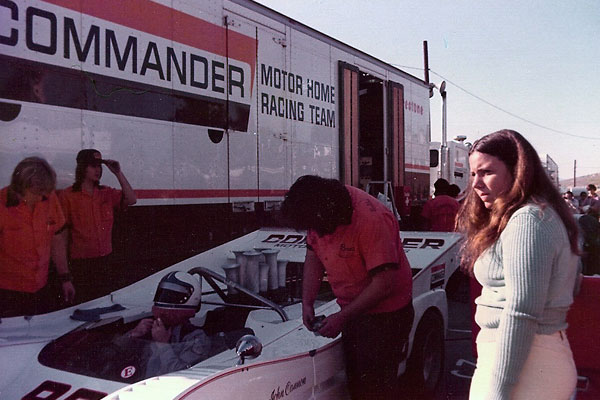
�
After Danny Hopkins crashed M8FP 72-09 at Edmonton, the team rushed to prepare a replacement.
�
Here's John Cannon at Laguna Seca, getting ready to qualify in the team's second number 98
�
McLaren. Mark Ellis and David Kapter stand by as Bruce Robles tapes down door tabs.
�
The Second Number 98 McLaren
��
After Danny Hopkins suffered a bad shunt at Edmonton, the Commander team worked quickly to�
complete construction of a replacement McLaren M8F. It was built on a different tub, but many parts�
from Danny Hopkin's car were transferred over. John Cannon was recruited to drive it.�
(Cannon had scored a sixth place finish at Mosport and a fifth place finish at Watkins Glen�
earlier in 1973 for Motschenbacher Racing.) Bobby Brown would continue to drive the number 97 car.�
Mario Andretti was still under contract to drive the team's number 96 McLaren M20 when he didn't�
have conflicting obligations, which included the season's last two races.�
�
�
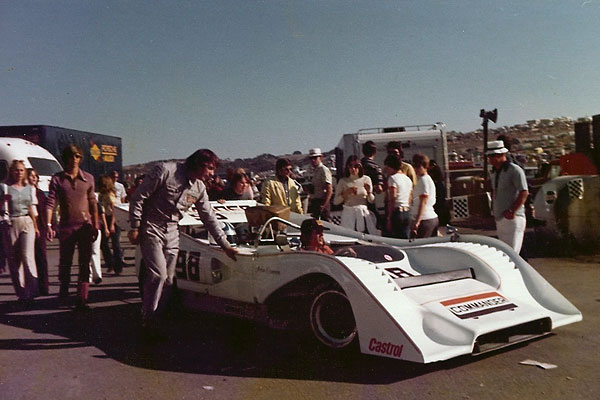
�
John Cannon helps push his McLaren M8F through the paddock at Laguna Seca, 1973. David Kapter
�
steers. Note the distinctive "shovel nose" and updated livery compared to M8FP 72-09 (above.)
�
�
Compared to its predecessor, the second number 98 McLaren had several very significant�
performance upgrades:�
�
Firstly, in lieu of regular McLaren M8F front bodywork, the team created a custom shovel nose.�
Its scooped shape, in combination with new louvers over the tires on the forward-facing surface,�
resembled Porsche's 917-10 and 917-30 models. Result: more downforce, resulting in more�
traction for the front tires.�
�
�
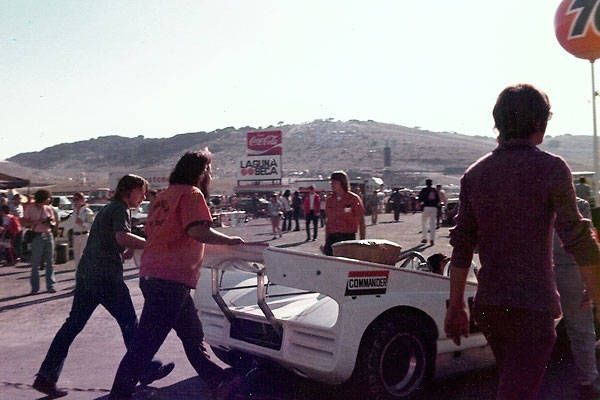
�
Bruce Robles helps push the McLaren M8F through the paddock at Laguna Seca.
�
Note the distinctive rear wing placement, much further back than other M8Fs! The vertical
�
wing supports were special too, being constucted of airfoil tubing and being dog-legged
�
to come through an existing opening at the rear of the bodywork, albeit notched for clearance,
�
instead of a coming through holes in the top surface. (We'll come back to this point later.)
�
�
Secondly, the rear wing was relocated rearward where it would be more effective due to cleaner�
airflow. Also, very importantly, rearward placement of the wing means that aerodynamic downforce�
is applied through a longer lever arm to achieve more mechanical advantage.�
�
�
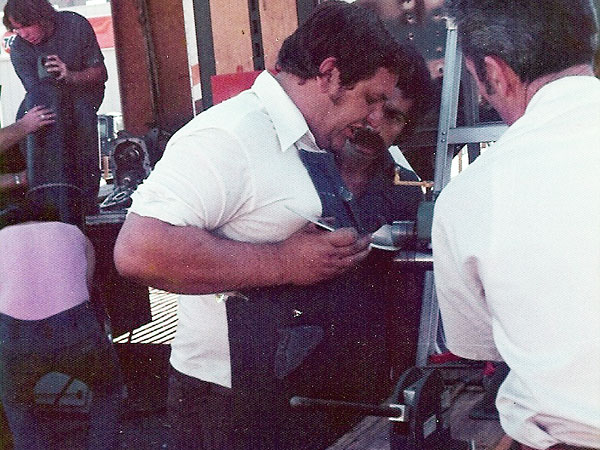
�
Can-Am scrutineers objected to Commander's new number 98 car because it was fitted with
�
larger rear tires that extended outward beyond the bodywork. The team rushed to make and
�
install fender flares that would bring their car into compliance. Bill "The King" Eaton
�
is shown here rolling a flare to refine its shape. Charlie Agapiou is to his left.
�
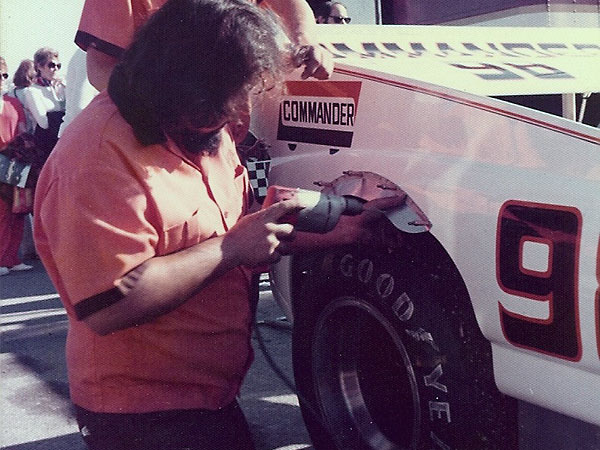
�
Bruce Robles is shown fitting the new fender flares in the Laguna Seca paddock.
�
�
Thirdly, bigger rear tires. Back in 1968, John Cannon had dominated a rainy Laguna Seca Can-Am �
by shrewdly snapping up the only set of intermediate (rain) tires Firestone had brought to the track�
that weekend. No one knew better then Cannon the importance of being on the "right" tires!�
For 1973, the right tires were the big Goodyears that had been developed for the Penske Porsches.�
Cannon would have them on his McLaren M8F, even though they were so wide that their�
installation necessitated installation of fender flares. (The Commander team had used narrower�
Firestone tires on the number 97 car and on the first number 98 car.) After testing the Goodyear�
tires on the number 98 car at Laguna Seca, the Commander team believed they were worth at�
least half a second per lap.�
�
Fourthly, Commander team mechanics updated the car's front suspension geometry by fitting�
McLaren M20-spec magnesium uprights and control arms. M8F and M20 uprights are made from the�
same magnesium casting; the difference lies in how they're machined. The overall height of�
an M8F front upright is 11.30" versus 10.810" for the M20. All of that height difference�
comes from removing 0.49" from the bottom surface, which also brought the lower connection�
point closer to hub centerline. Of course, it's very hard to second guess the significance�
of this change forty years hence. One interesting point: original M20 control arms were�
fabricated from 4130 (Chrome Moly steel), and the Commander team neither painted nor plated�
them. By 1973, racers were becoming aware that chrome plating can cause or exacerbate hydrogen�
embrittlement, causing welds to fracture. Paint makes welds more difficult to inspect.�
�
�
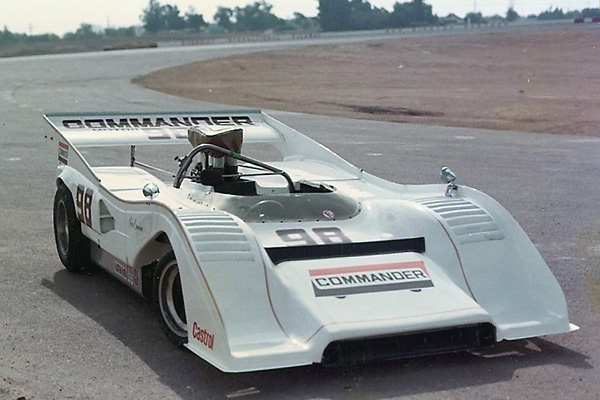
�
John Cannon's M8F as it was presented at Riverside for the final event of the 1973 Can-Am season.
�
�
The harsh reality was that even with absolutely state-of-the-art tires, aerodynamics, and�
suspension geometry, nobody could've been competitive in 1973 Can-Am racing without a�
turbocharged engine. (Among turbocharged engines, the factory-backed Porsches had an�
"unfair advantage" or two.) Top tier turbocharged engines were producing over 1100hp�
at the wheels.�
�
Once race worthy, the Commander team's second number 98 car would likely vie for "best in class"�
against Jackie Oliver's Shadow among naturally aspirated cars. (If restored to Commander's�
preparation level, it might also be the fastest McLaren M8F in vintage Can-Am racing.) �
�
The Commander team was faced with a paradox: their turbocharged M20 had the power to be�
competitive, but couldn't win with legendary driver Mario Andretti at the wheel because�
of a personal sponsorship contract Andretti had with Firestone. The contract prohibited Andretti�
from racing on anyone else's tires, even though Firestone didn't produce a competitive�
tire for Can-Am. Goodyears were the only tires worth having. John Cannon had Goodyears�
on his M8F. Commander might possibly have a winning combination if they moved John Cannon�
and his tires to the turbocharged M20. It wasn't until the very last opportunity that�
they tried this combination.�
�
At Laguna Seca, John Cannon drove the newly built M8F to qualify 8th fastest, at 1:01.927.�
In the turbocharged M20, Mario Andretti qualified 13th, at 1:03.303.�
�
In 1973, Can-Am races were divided into two heats: first a short "sprint race" followed by�
a longer "cup race". Results from the sprint race determined starting order for the cup race.�
Due to tire (traction) and oil pressure problems, Mario Andretti�
decided to go home after the sprint. John Cannon therefore parked his M8F after the sprint�
race in order to try out the turbocharged car. Just three laps into the cup race, Cannon was�
involved in a six-car accident and damaged bodywork forced his withdrawal from the race. �
�
At Riverside, Andretti drove the M20 to qualify 8th fastest, at 1:15.191. Cannon qualified�
10th fastest at 1:15.393. In the sprint race, Cannon completed 24 laps (of 30) before an�
engine failure forced him to retire the number 98 car. A quick engine swap would be required�
if the number 98 car were to compete in the cup race. Andretti's sprint race results don't�
show up in official race reports, although many people believe they saw him there.�
�
Since Cannon had tested the M20 at Riverside, the Commander team had Cannon's M20 seat,�
foot peddles and steering column in their hauler. They went to work installing them, and also�
switching over wheels and tires. Because of the driver change, Cannon was required to start�
at the rear of the field. In fact, he was working his way up though the field with very competitive�
laptimes until about lap twelve (of 49) when a needle bearing came adrift from a rocker arm in�
the engine and worked its way to the oil pump ending his race due to oil pressure problems. �
Riverside was particularly grueling that year. Of 24 cars qualifying, only eight�
were running at the finish. Mark Donohue won with ease; it was his sixth victory in a row.�
The Commander Motor Homes Team seemed to have tremendous potential, but very little luck.�
�
�
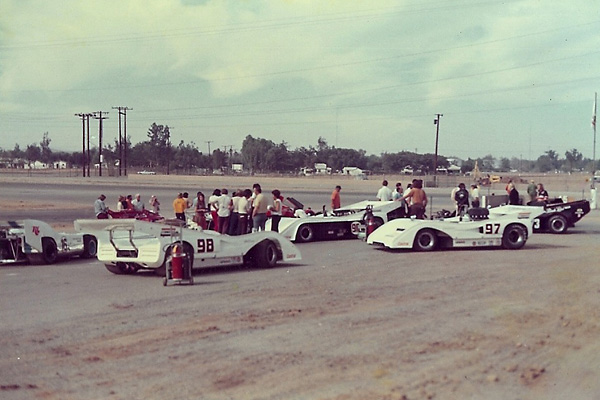
�
Three Commander Motor Homes team cars ready for Friday morning practice at Riverside, October 1973.
�
Also shown (at left) George Follmer's ex-Penske 1972 championship winning Porsche 917-10K as it
�
appeared in 1973 with Rinzler / RC Cola livery.
�
�
After the 1973 season ended, Commander decided not to continue in Can-Am racing. They sold all�
five of their McLaren sports cars. The Commander team's second number 98 car is only known�
to have raced a couple more times in the 1970s.² �
�
�
 �
�
�
�
McLaren's M8F Model
��
The M8F was McLaren's fifth and final championship-winning Can-Am model. Team drivers Peter�
Revson and Denny Hulme drove M8F racecars to a 1-2 finish in 1971 championship points.�
Revson won five of the ten Can Am races in 1971, and Hulme won three others.�
The combined success of the M8 lineage had been brought to thirty-seven wins in forty-three�
races, spread over five seasons. At season's end, the McLaren team sold off its M8F racecars�
(Revson's M8F-01 and Hulme's M8F-02), and committed themselves to developing a new model.�
The McLaren team was ready to move on to a whole new car for 1972. As they had done with�
earlier models, McLaren licensed the M8F design to Trojan. Trojan produced nine complete�
M8FP cars for customers, and also distributed repair parts to second-tier teams.�
�
Design credit for the M8F model belongs to McLaren team member Gordon Coppuck, but with�
qualification because much of the design carried over from previous Can-Am models�
and because a few parts were shared with or based closely on McLaren Indianapolis�
500 (open wheel) car designs. Preceding variants of the design had been credited to�
Bruce McLaren, Robin Herd, and Jo Marquart.) All these cars shared essentially similar construction; �
�
As described in original McLaren sales literature: "The M8F is constructed from 16 and�
20 gauge L72 aluminium alloy with Argon welded steel bulkheads, bonded and riveted;�
designed to use a 7-8 litre Chevrolet engine as a stressed unit of the chassis. The�
suspension pick-up points are taken from the steel bulkheads to give maximum strength.�
The outer sections of the monocoque are used to carry the fuel, thus ensuring a low�
centre of gravity." Compared to the previous season's M8D model, the new monocoque�
tub supported a three inch longer wheelbase yet provided improved stiffness.�
�
The original McLaren team raced their M8Fs with two distinctly different engines. They started�
the season with Chevrolet-produced iron-sleeved aluminum engine blocks. Gary Knutson built these�
up to 494cid, (4.44" bore, 4.0" stroke.) McLaren also and more famously raced the M8F with "Reynolds�
motors". The Reynolds engines used special linerless high silicon aluminum blocks. Without�
liners, cylinder bores could be slightly larger without changing cylinder centerline spacing. Knutson�
started conservatively, but ultimately built the Reynolds engines up to 509cid (4.50" bore, 4.00"�
stroke.) One problem with the Reynolds motor was that it required very specially plated pistons�
that were in short supply. Knutson is also credited for McLaren's use of staggered length intake�
trumpets. By using two different intake tract lenghes, he was able to smooth a double-humped torque�
curve that had been characteristic of big Chevy V8's used previously in Can-Am. �
�
�
IMPORTANT ANNOUNCEMENT
�
BritishRaceCar.com will have to cut back plans for continued growth if we can't find more financial support.
�
If you like what you've found here, and you want to see more, please click here and follow the instructions.
�
Readers like you keep BritishRaceCar.com online and growing through voluntary financial contributions.
�
Features and Specifications
�| Engine: | �Dart aluminum "Big M" engine block (current displacement: ~503cid). �
Winters Foundry aluminum cylinder heads.�
Lucas - MacKay mechanical fuel injection.�
Vertex magneto ignition system.�
Specially modified dry sump with alloy tanks and Aeroquip oil lines and fittings. | �
| Cooling: | �aluminum double-pass radiator (with both ports on the bottom tank.) | �
| Exhaust: | �polished stainless steel four-into-one headers. | �
| Transaxle: | �Hewland LG-500 4 speed with reverse and limited slip differential. (1st:1.679, 2nd:1.344,�
3rd:1.083, 4th:0.923, and 3.30:1 final drive ratio.) Borg & Beck sintered three plate clutch.�
Trojan/BRD roller splined drive shafts. | �
| Front Susp.: | �dual wide-based wishbones.�
Koni aluminium telescopic double adjustable shock absorbers.�
Cast magnesium (L127) hub carrier.�
Hollow forged EN39 axles on needle roller bearings.�
Rack and pinion steering in magnesium housing.�
Standard front springs, rated 535 lb./in.�
Adjustable anti-sway bar. | �
| Rear Susp.: | �independent, with transverse link, radius arms and lower parallel links.�
Koni aluminium telescopic double adjustableshock absorbers.�
Cast magnesium (L127) hub carrier.�
Hollow forged EN39 axles on needle roller bearings.�
Standard front springs rated, 620 lb./in. | �
| Brakes: | �(master) dual Tilton master cylinders (not original) with plastic reservoirs and adjustable bias bar. � (front) Lockheed 11.90" x 1.25" ventilated discs with CP2279 calipers. � (rear) Lockheed 11.90" x 1.10" ventilated discs. | �
| Wheels/Tires: | �magnesium wheels (15x11 front and 15x17 rear).�
Avon front tires.�
GoodYear Eagle rear tires. | �
| Instruments: | �(left to right) �
AutoMeter transmission oil temperature (100-250F),�
AutoMeter engine oil temperature (100-250F),�
Stewart Warner engine water temperature (0-200F),�
Smiths engine water temperature (120-260F),�
Stewart Warner engine oil pressure (0-100psi),�
Jones mechanical tachometer (0-10,000rpm). | �
| Fuel System: | �4 rubber fuel cells (57 U.S. gallons, total.) | �
| Safety Eqpmt: | �Schroth Racing 6-point cam-lock safety harness.�
Personal steering wheel, mounted on universally jointed steering column. | �
| Weight: | �1520# | �
| Racing Class: | �Can-Am | �
 �
�
�
�
Engine Installation
��
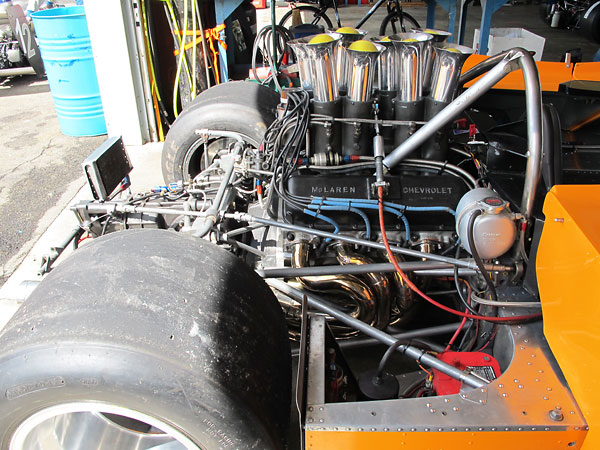
�
In lieu of a vintage engine, Scott's car uses a modern aftermarket Dart aluminum engine block.
�
A car with such a powerful engine must have a strong and rigid chassis. Remarkably, McLaren
�
advertised that their monocoque aluminum chassis weighed only ninety-eight pounds.
�
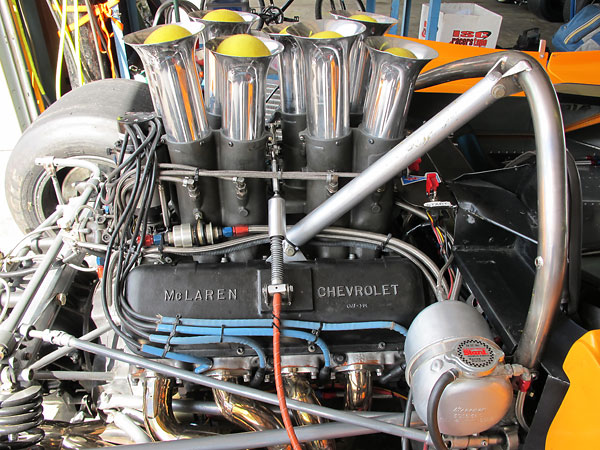
�
Lucas fuel injection provided very precise fuel metering at all engine speeds and throttle positions plus
�
excellent vaporization. However, Lucas didn't offer a complete injection system: they only produced the
�
metering components. Companies like MacKay and Kinsler produced manifolds, drives, linkages, etc.
�
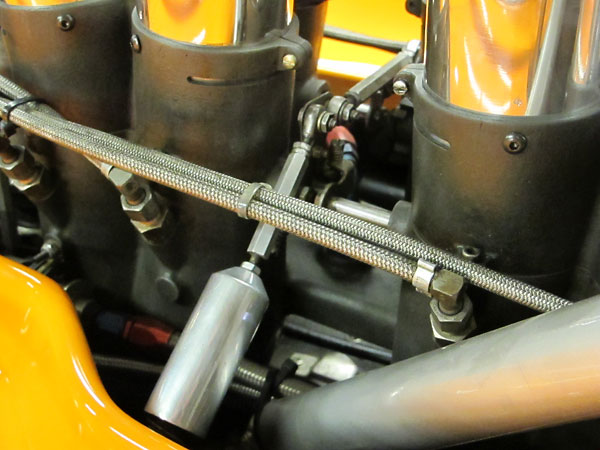
�
Throttle linkage, attached to MacKay fuel injection throttle bodies.
�
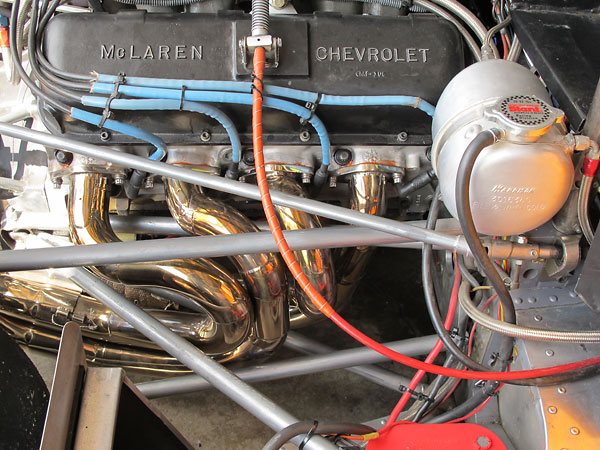
�
The McLaren team used stainless steel headers. Trojan-produced M8Fs came with mild steel headers.
�
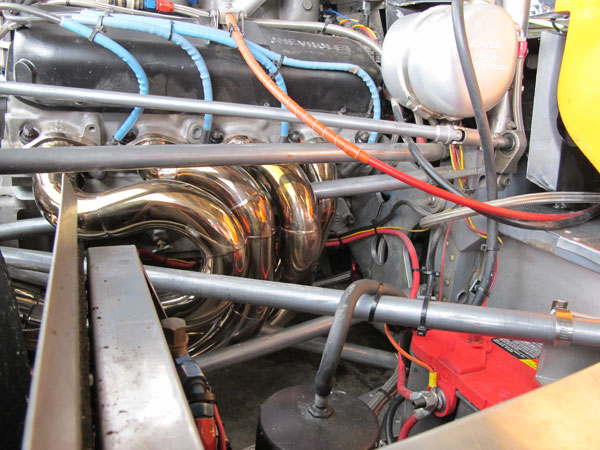
�
Thick aluminum front engine mounting plate.
�
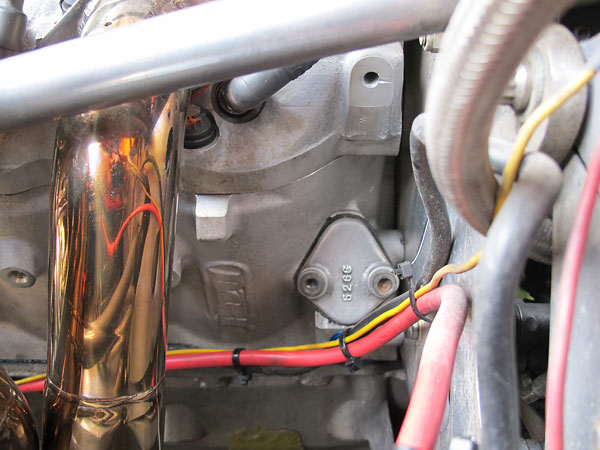
�
Dart "Big M" aluminum engine block.
�
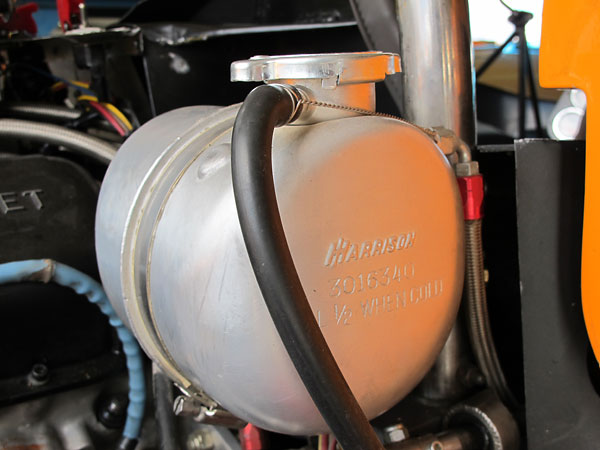
�
Harrison 3016340 aluminum coolant header tank.
�
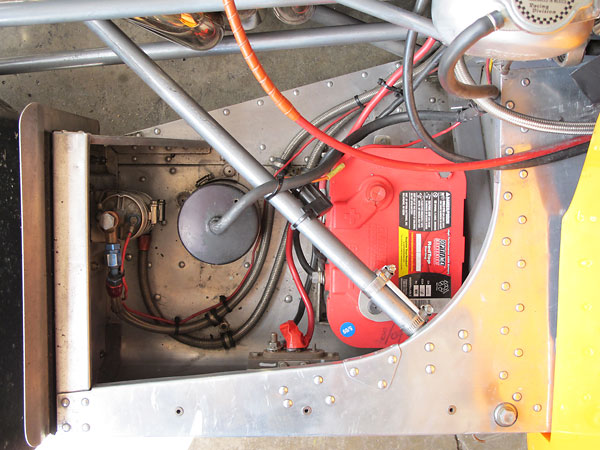
�
Optima Red Top high performance AGM battery.
�
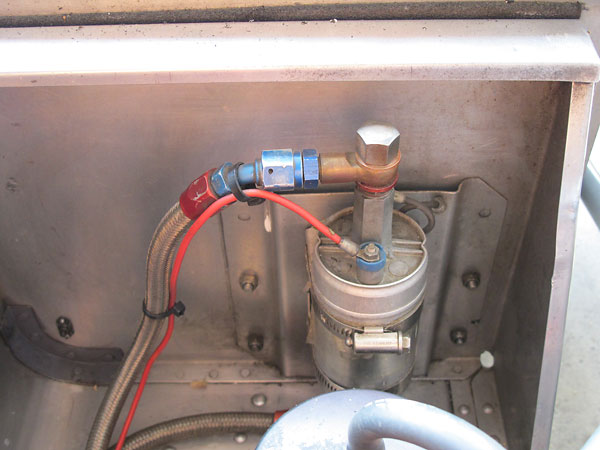
�
An electric "starter" fuel pump runs until the engine gets up to speed. After that, a mechanical
�
pump (driven off the crankshaft) takes over.
�
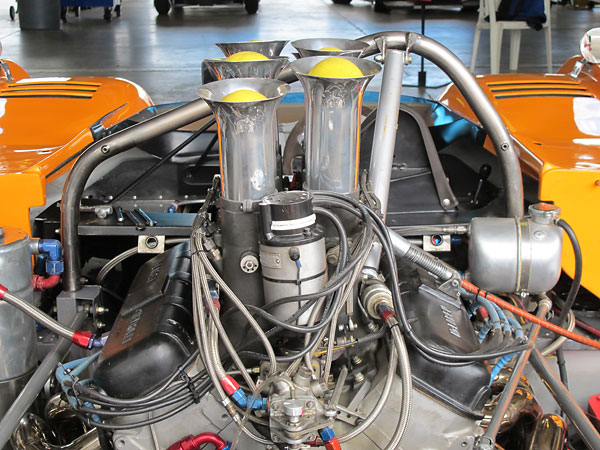
�
�
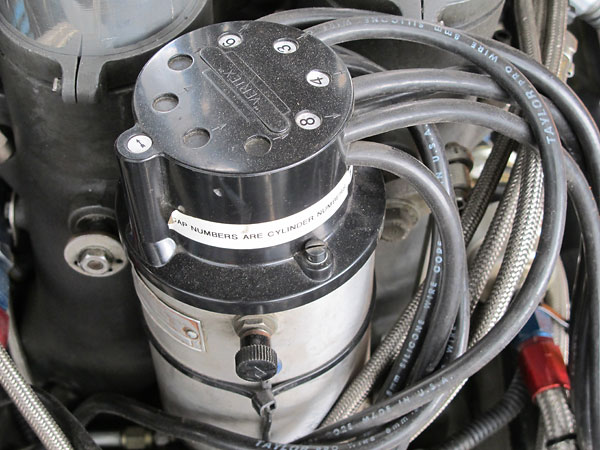
�
Vertex magneto: "Cap numbers are cylinder numbers."
�
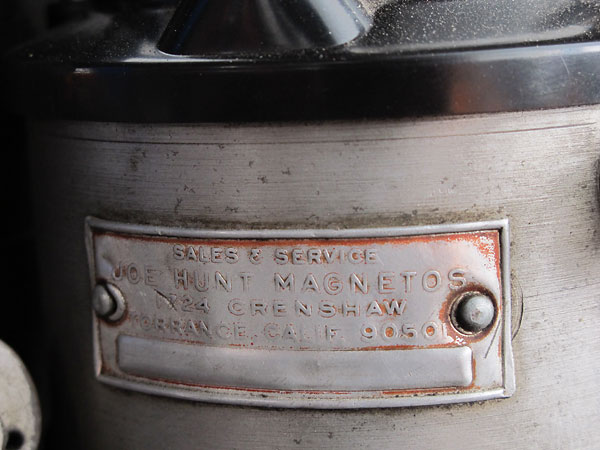
�
Sales and Service
Joe Hunt Magnetos
1724 Crenshaw
Torrance Calif 90501
�
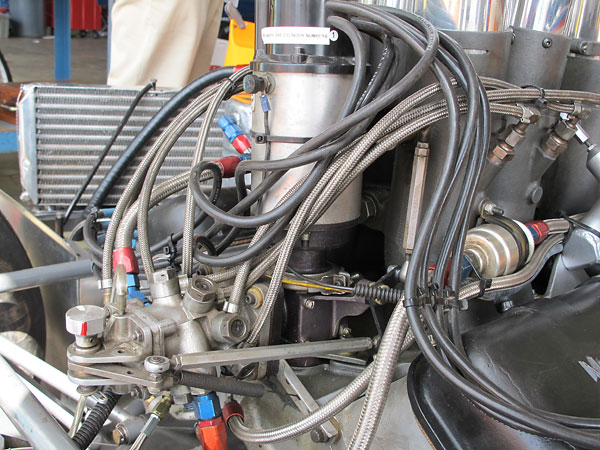
�
The magneto and a Lucas fuel injection metering unit share a common drive mechanism.
�
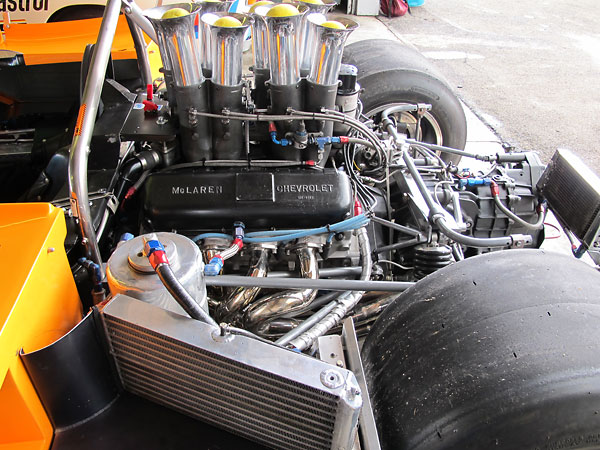
�
A large NACA duct on the passenger side of the body directs air into a single engine oil cooler.
�
The driver side duct isn't directed anywhere in particular.
�
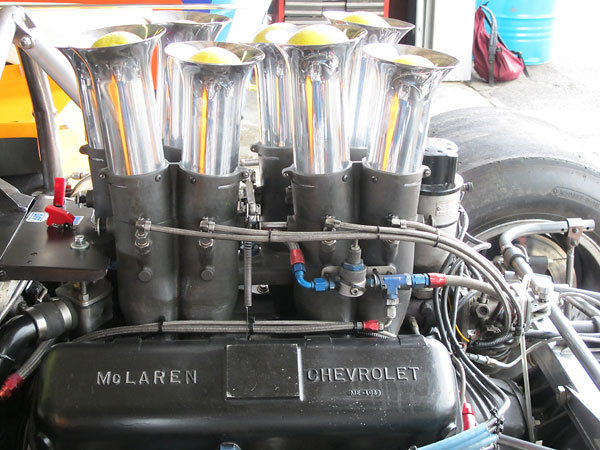
�
McLaren engine builder Gary Knutson developed staggered intake trumpets to tame a double-hump
�
torque curve that had been characteristic of big Chevy V8's used previously in Can-Am.
�
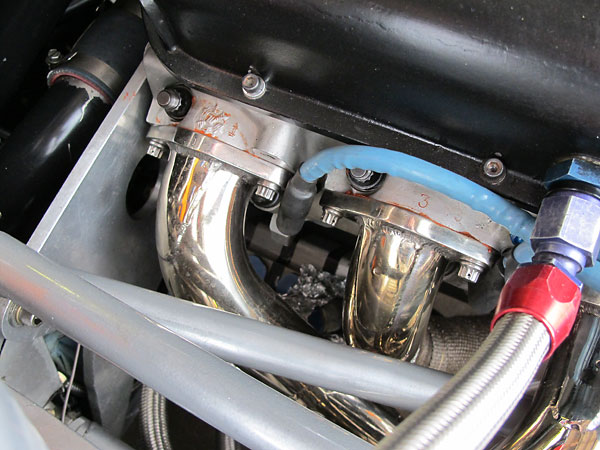
�
The snowflake logo casting mark tells us that these are Winters Foundry aluminum cylinder heads.
�
In this view we can just spy a large, multi-stage oil pump as required for a dry sump system.
�
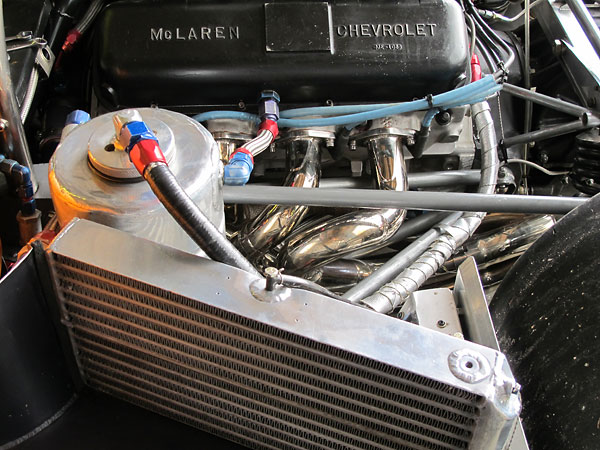
�
When McLaren and Trojan cooperated to develop a production car specification, they decided Trojan
�
would provide a dry-sump oil system of McLaren design, even though they weren't providing engines.
�
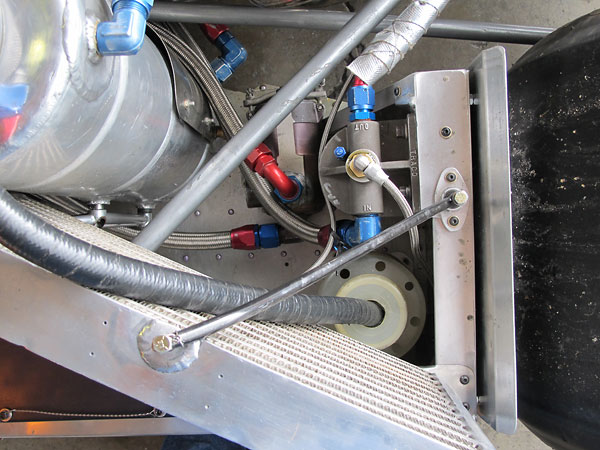
�
Traco remote oil filter mount.
�
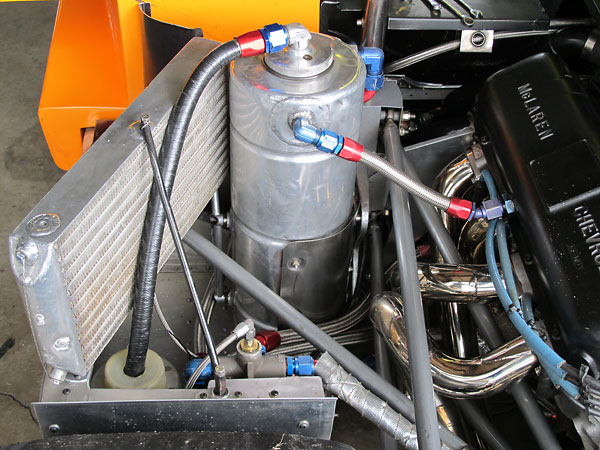
�
Aluminum engine oil cooler.
�
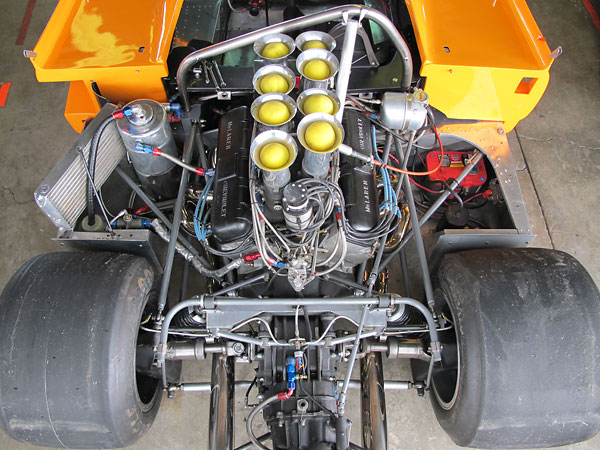
�
Aluminum engine oil reservoir.
�
�
Suspension / Transaxle / Etc.
��
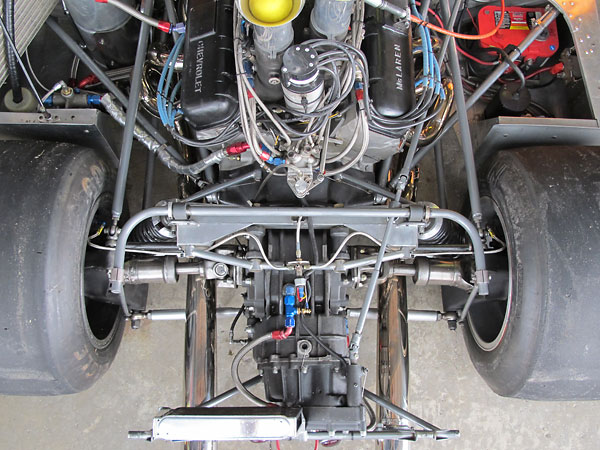
�
Basic dimensions: 98" wheelbase, 60" front track, 57.75" rear track, 167" overall length, 79.5"
�
overall width, 30" height to windscreen, 36" height to top of roll hoop, 1520 pounds dry weight.
�
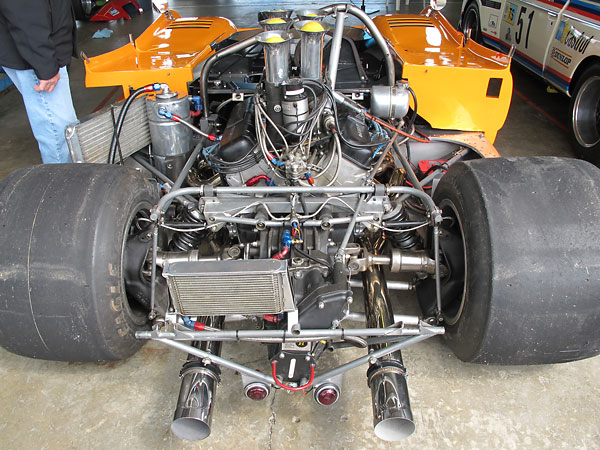
�
For 1970, on the McLaren M8D model, McLaren had experimented with a wide track design.
�
For 1971 they returned to more familiar proportions. (The difference was ~4" front and rear.)
�
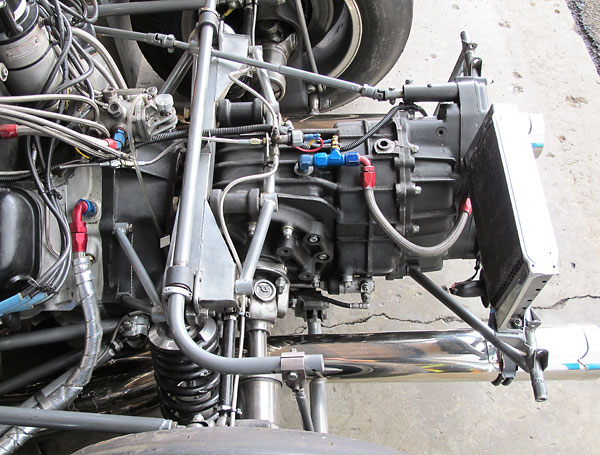
�
Hewland's LG500 MkII transaxles featured beefed up cases and side plates compared to the MkI model.
�
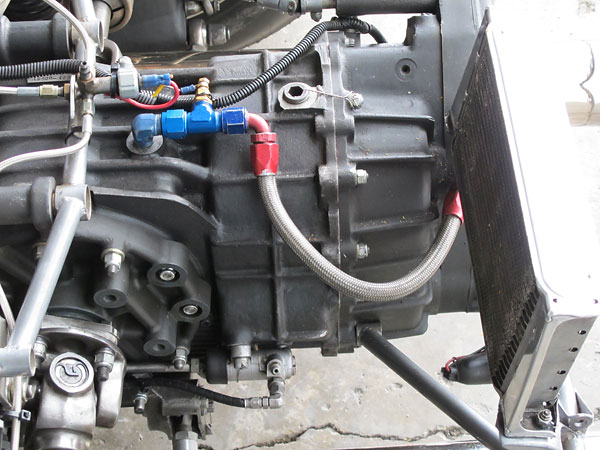
�
Girling clutch slave cylinder.
�
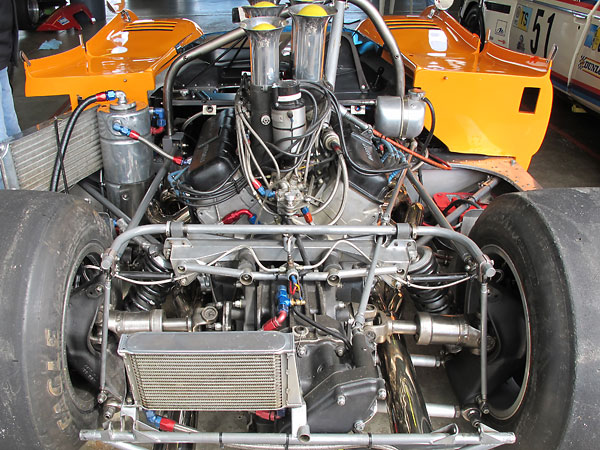
�
McLaren's flirtation with inboard mounted rear brakes resulted in a subtle but lasting change to
�
the rear suspension: reversed lower A-arms were replaced by Surtees-style parallel links. A
�
benefit of this change was reduced bump steer. Other differences from the previous (M8D) model
�
resulted in better camber change curves (front and rear) and increased anti-squat.
�
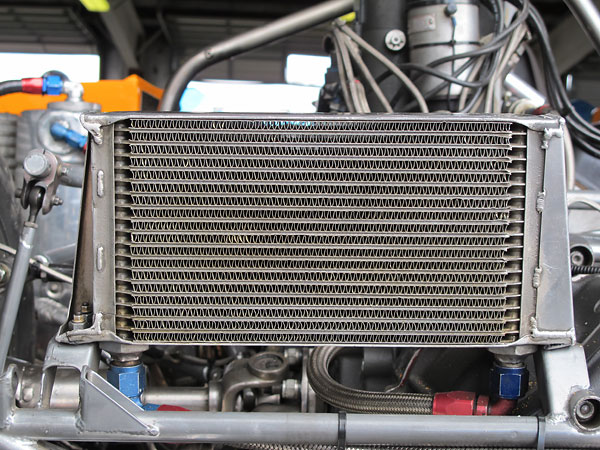
�
19-row transaxle oil cooler.
�
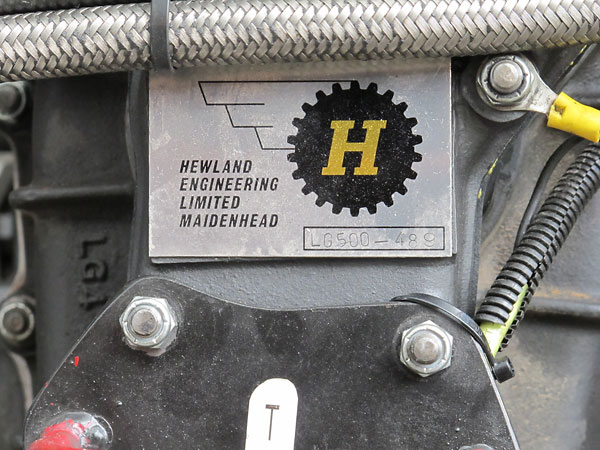
�
Hewland Engineering Limited Maidenhead, LG500-489
�
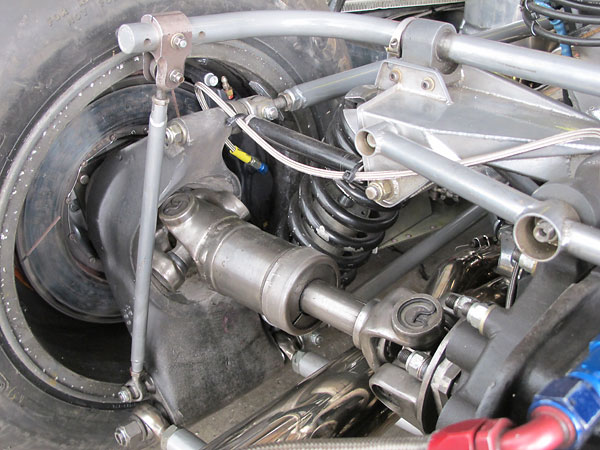
�
Adjustable rear anti-sway bar.
�
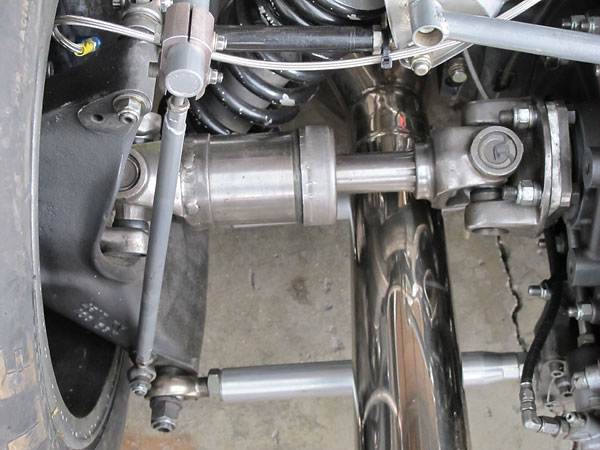
�
Trojan/BRD roller splined drive shafts.
�
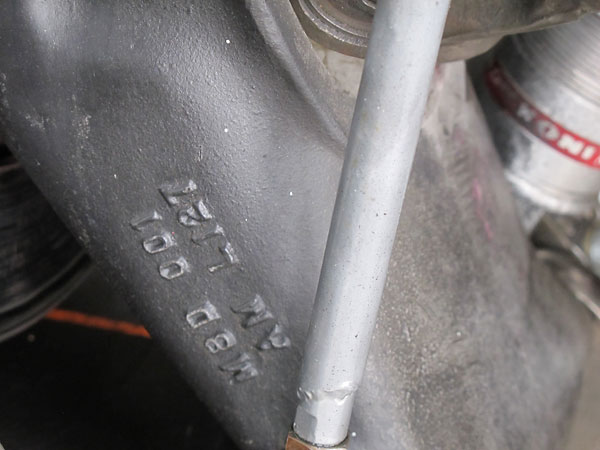
�
McLaren cast magnesium (L127) hub carrier, marked "M8D 001 AM L127".
�
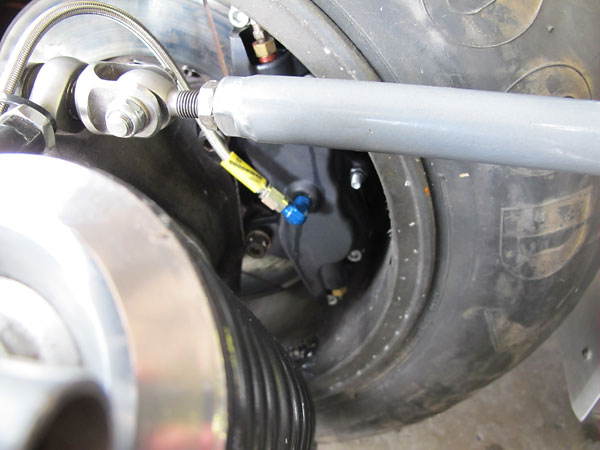
�
The McLaren team originally equipped its own M8Fs with inboard mounted rotors and Lockheed
�
CP2270 calipers. By mid season they had moved the rear brakes back outboard, and that's
�
where they appear on the Trojan produced M8FPs.
�
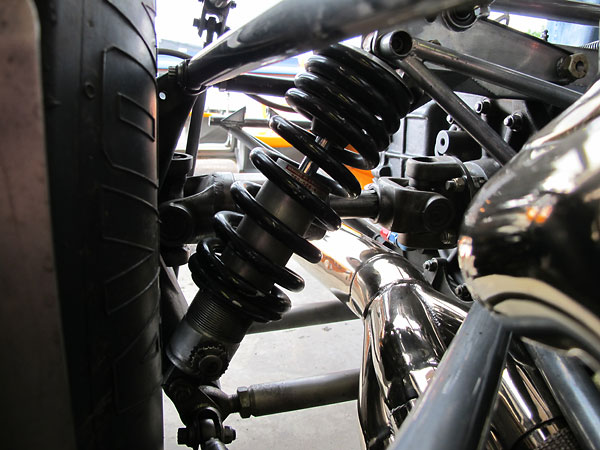
�
Koni aluminium telescopic double acting shock absorber.
�
�
Interior
��
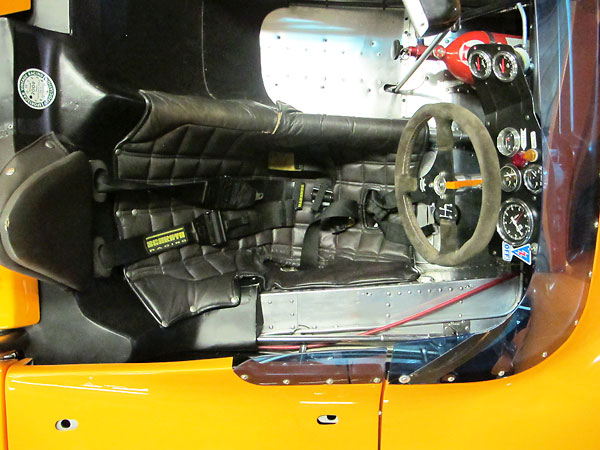
�
The McLaren M8F featured 3" of extra length, added right in the middle. This length helped
�
shift weight bias rearward, but it was also favorable in terms of driver comfort. It was
�
introduced concurrently with introduction of a four-bag fuel cell layout (two bags per
�
pontoon) in lieu of the earlier two-bag layout of the previous year's model.
�
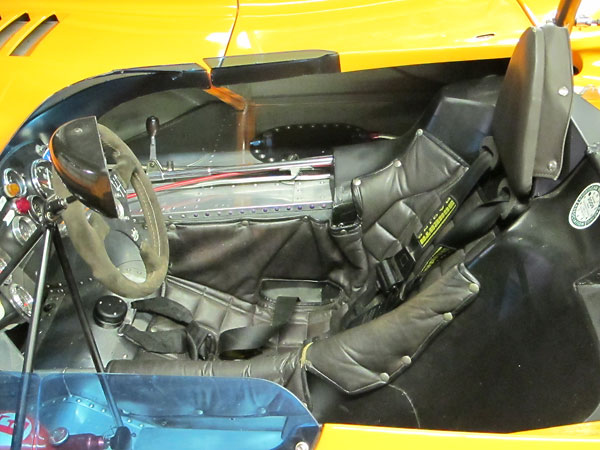
�
Schroth Racing 6-point cam-lock safety harness.
�
Personal steering wheel, mounted on universally jointed steering column.
�
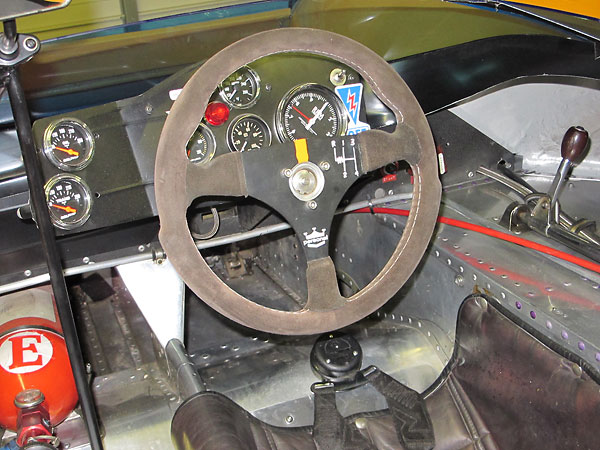
�
Former Commander mechanic John Nobles says this current dashboard is substantially different
�
from how they built and raced the car. We're looking for a period photo to illustrate the difference.
�
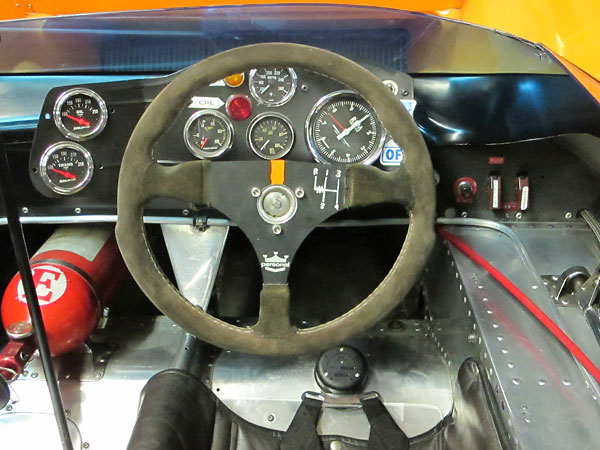
�
(left to right) AutoMeter transmission and engine oil temperature gauges, Stewart Warner
�
and Smiths water temperature gauges (0-200F and 120-260F respectively), Stewart Warner
�
engine oil pressure gauge, and Jones mechanical tachometer (0-10,000rpm).
�
�
Exterior
��
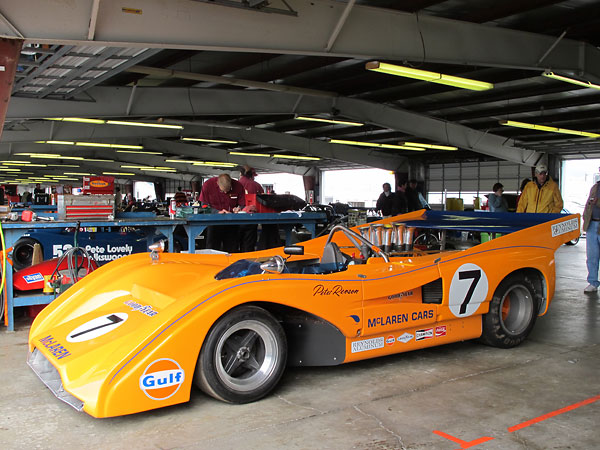
�
Scott Hughes' McLaren M8F as presented in the garages at Watkins Glen International for the
�
"Glenora Wine Cellars 2010 U.S. Vintage Grand Prix, presented by Welliver McGuire"
�
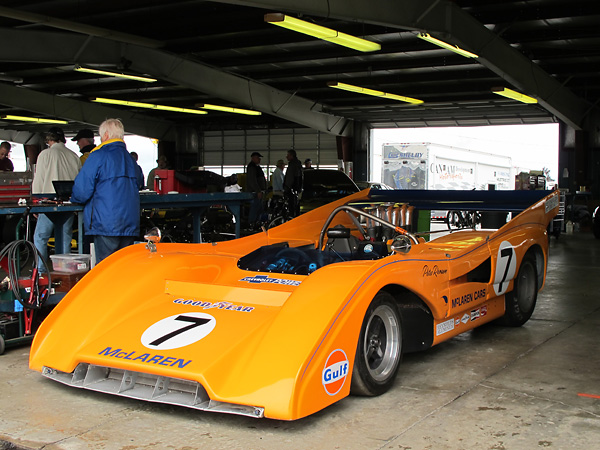
�
Scott's M8F is qualified to vintage race in Sportscar Vintage Racing Association's "7ASR" class.
�
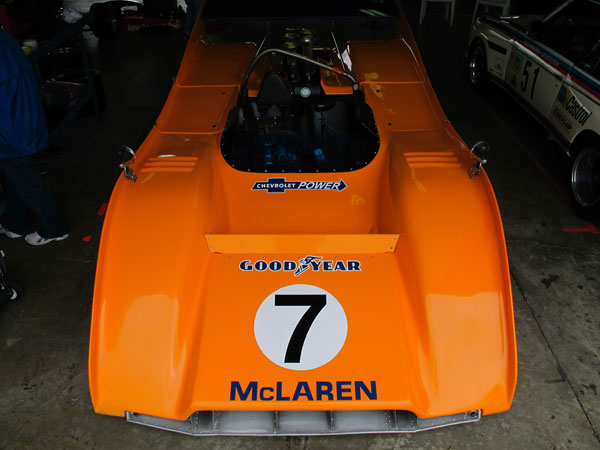
�
At the 2010 U.S. Vintage Grand Prix seven other 7ASR cars were entered including a Lola T163, the
�
Matich SR3, the McKee Mk10, and a McLaren Mk12 (i.e. an M8A body on top of a M6B chassis.) These
�
were all somewhat earlier Can-Am cars. The 7ASR class also included a "March 817 Can-Am" which is
�
a car from the much later single-seat Can-Am era. It was about ten seconds per lap quicker...
�
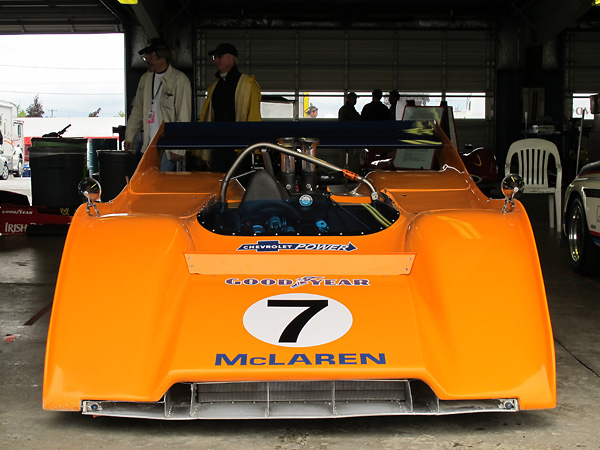
�
McLaren built the first M8F - Peter Revson's car - with a simple trapezoidal radiator opening. However,
�
the opening was extended to both sides on later M8Fs including Denny Hulmes' car and the Trojan cars.
�
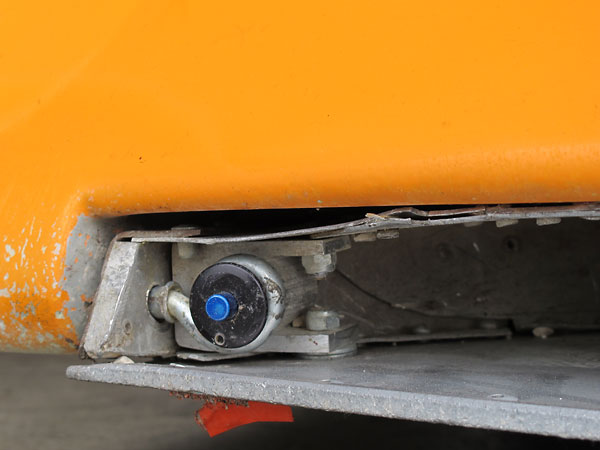
�
Hold-down "pip pins" are located at the far ends of the opening's extensions.
�
(This is different from the original McLaren design.)
�
�
Enjoying this article? www.BritishRaceCar.com is partially funded through generous support from readers like you!
�
To contribute to our operating budget, please click here and follow the instructions.
�
(Suggested contribution is twenty bucks per year. Feel free to give more!)�
�
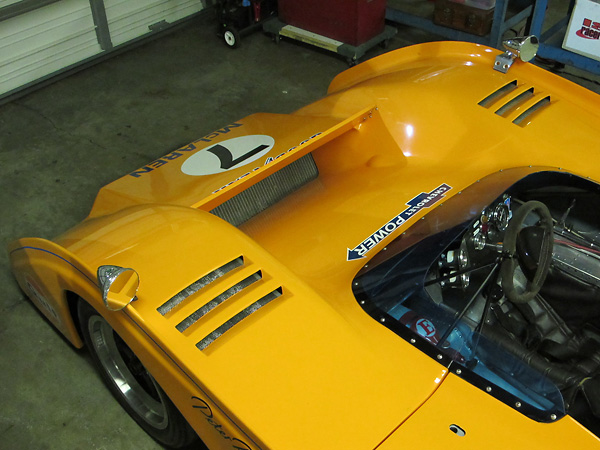
�
Marston aluminum double-pass radiator.
�
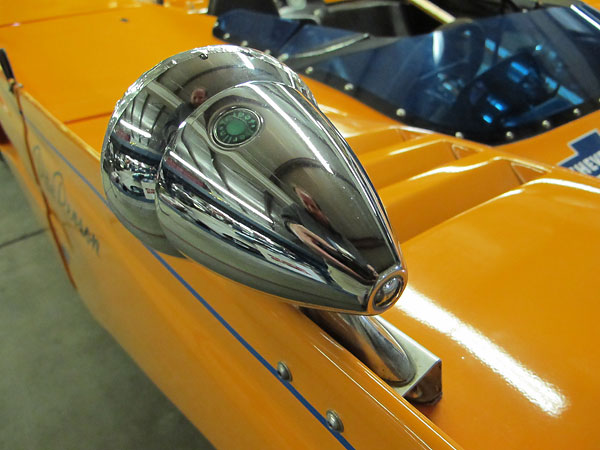
�
Talbot Berlin mirror.
�
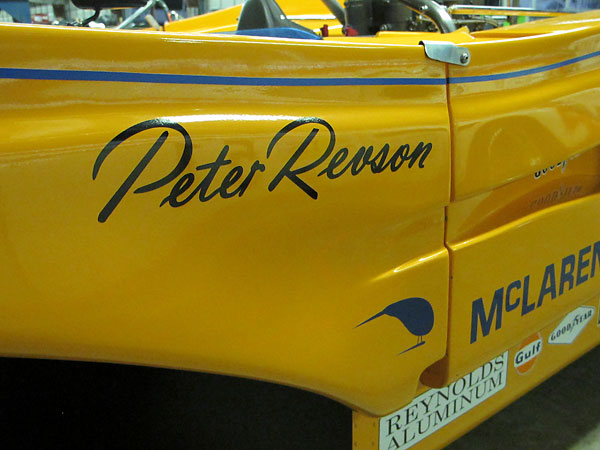
�
American driver Peter Revson tied with Mark Donohue as the second most successful driver in terms
�
of career Can-Am championship points. Revson appeared in seven of the series' nine seasons, and
�
he won the Can-Am championship in 1971 by scoring 142 points and winning five of the ten races.
�
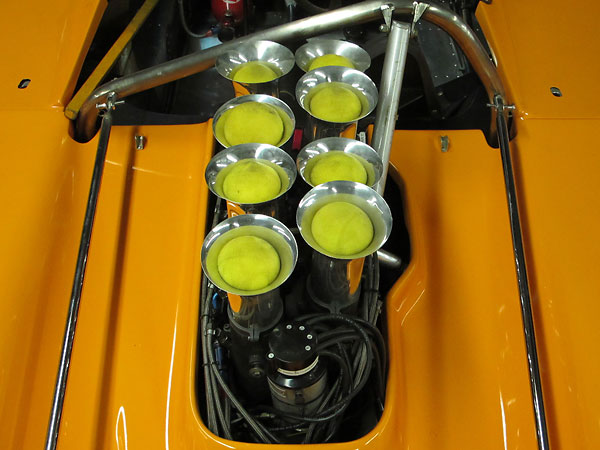
�
The most successful driver in Can-Am history was Revson's teammate Denny Hulme. Hulme scored 132
�
points and won three races in 1971. He had previously won the 1968 and 1970 Can-Am championships.
�
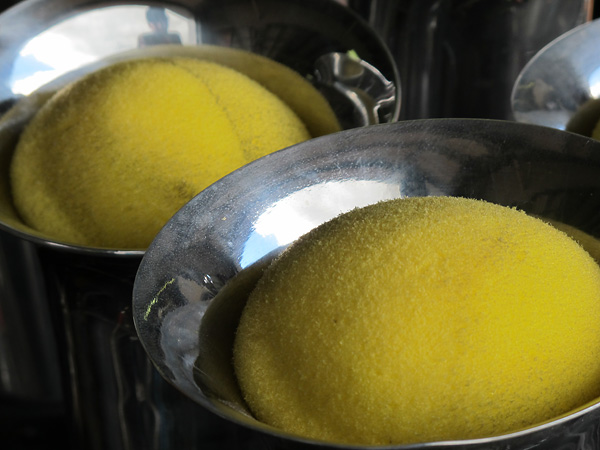
�
After the 1973 season, Commander Motor Homes sold the real Peter Revson M8F to Dan Hanna. M8F-01
�
was badly wrecked during Hanna's ownership. Chuck Haines rebuilt it around a new tub. The complete and
�
theoretically raceable car is now owned by Evert Louwman and is on display in his museum in Holland.
�
Louwman also owns what's left of the original monocoque chassis including the floor and one pontoon.
�
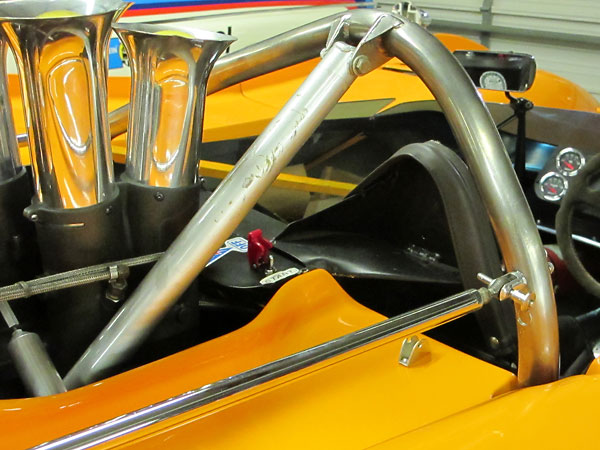
�
The roll hoop is titanium, which was a new and unique to the M8F model. However, you can see here that
�
the rearward brace to the engine is steel. On original McLaren team cars, these braces were titanium.
�
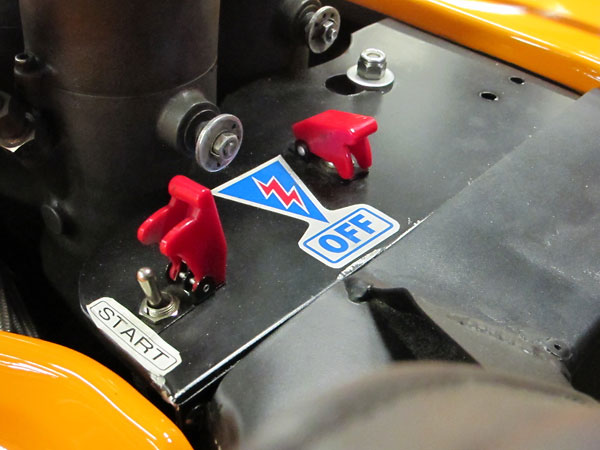
�
Kill switch and starter switch mounted behind the drivers headrest.
�
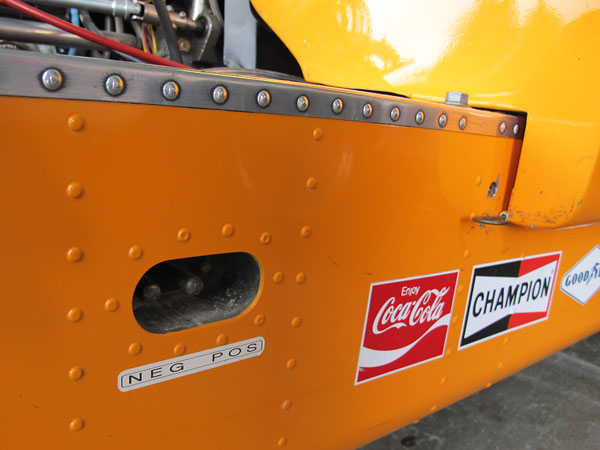
�
Quick coupling for jump starting and battery charging. Note that the pontoon sides are made of 0.062"
�
thick aluminum. This uncommonly stout choice was an attempt to provide extra protection for fuel cells.
�
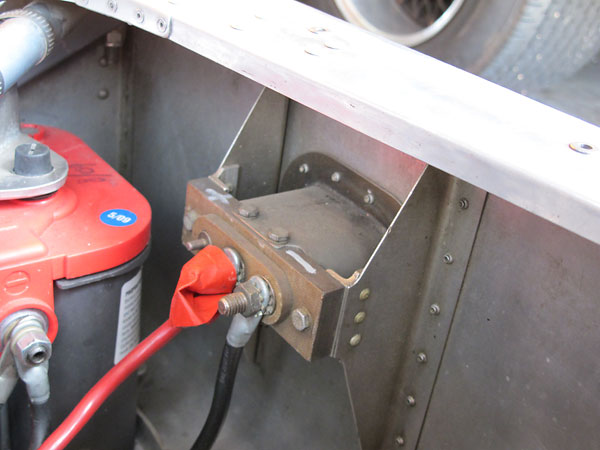
�
Connection detail for the jump start coupling.
�
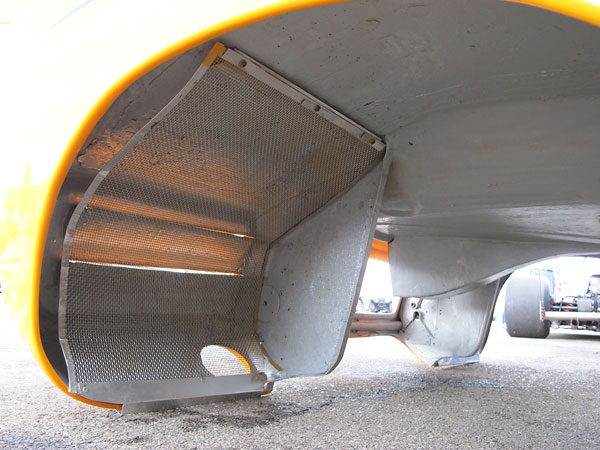
�
Rear bodywork detail, including stone screens for vents.
�
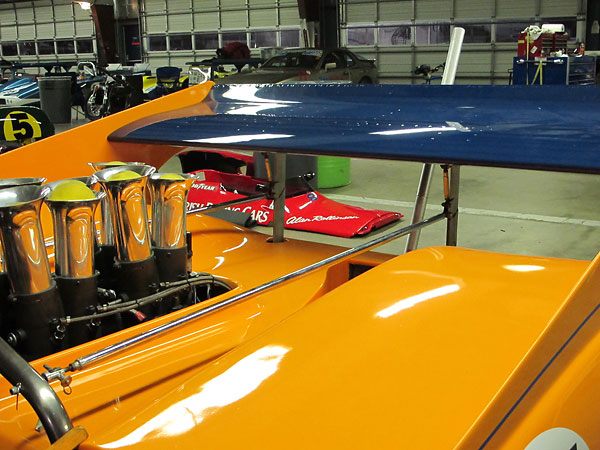
�
A single duct on the top of the body, passenger side, serves the transaxle oil cooler.
�
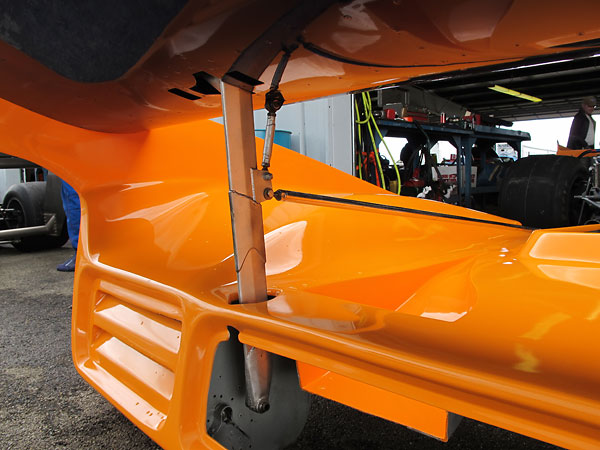
�
Earlier in this article we pointed out Commander's unique rearward wing installation. Clear signs of that
�
installation remain on the car now. Notice how the nickel-plated 4130 Aero-tube wing supports have
�
been cut and reworked. Patches have been added at mid-section, below the turnbuckle, to cover and
�
reinforce the splice. (Reinforcement patches weren't necessary on original M8F wing supports.)
�
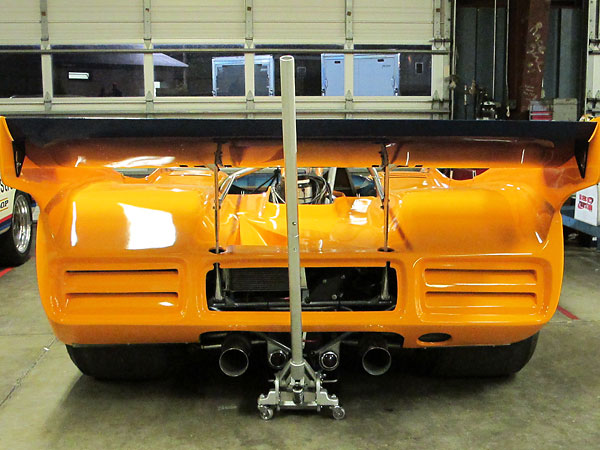
�
Commander also cut clearance notches in the fiberglass bodywork at the rear, where their dog-legged
�
wing supports came through the large opening. The notches are still there, even though the bodywork
�
has been otherwise modified to move the wing back to a forward position. In this view you can also see
�
one of the most distinctive features of the McLaren M8F model: its full length fender top fences. They
�
continue from the very front of the car to the back and help channel airflow to the rear wing.
�
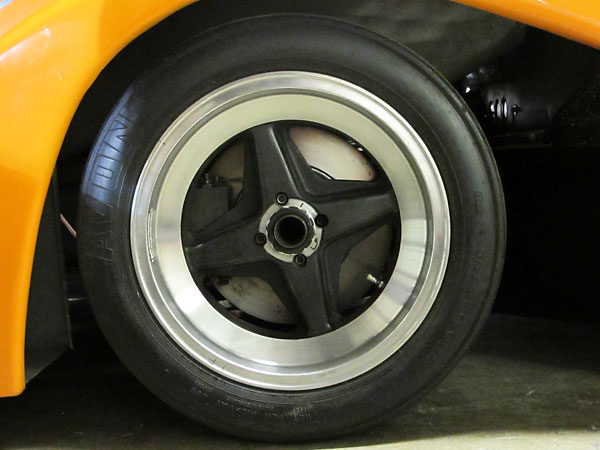
�
McLaren magnesium 15x11 front wheels, fitted with Avon tires.
�
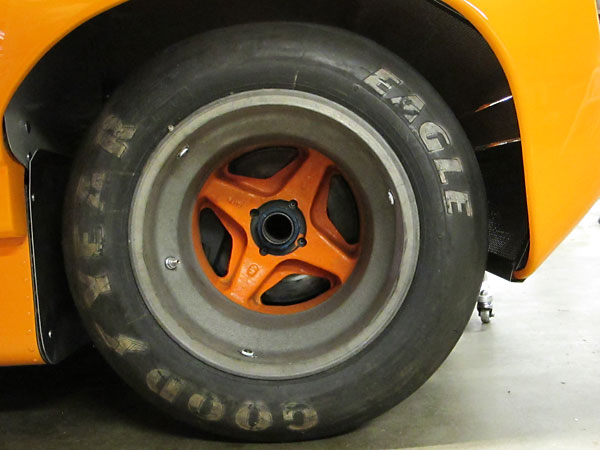
�
McLaren magnesium 15x17 rear wheels, fitted with Goodyear tires.
�
| Notes: | |||||||
| (1) | �
Although the Commander team's M20 isn't the central focus of this article, we'll take this�
opportunity to point out a couple interesting details. First and foremost, the turbocharger:�
� 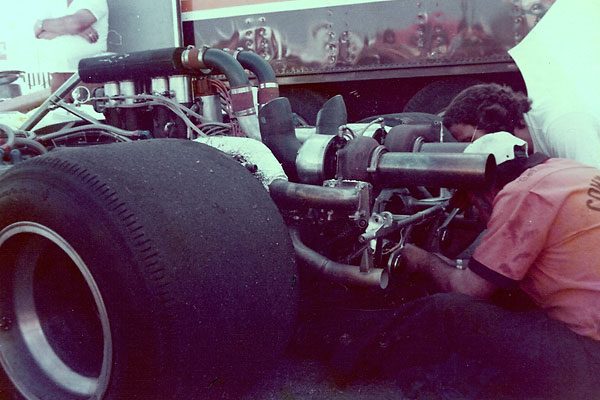 � � Commander's installation featured two fuel injection nozzles per cylinder, from two separate � Lucas metering units: one for low boost and the second for high boost. � 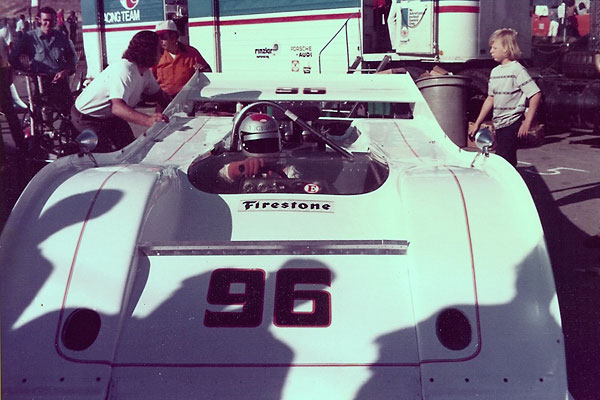 � � 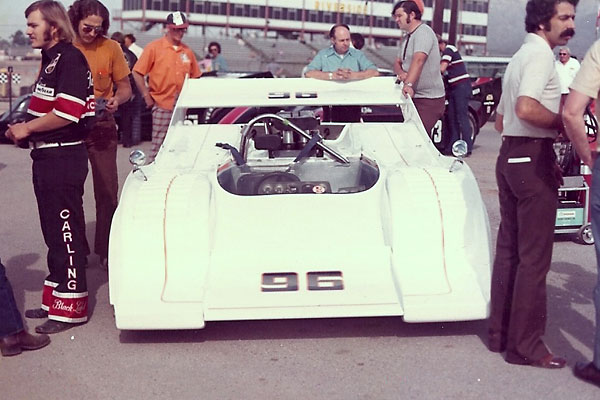 � � | ||||||
| (2) | �
This McLaren M8F was purchased from Commander by Eugene Nearburg as part of a package deal�
which also included the actual ex-Hulme McLaren M8F. Eugene's son Charles entered the number�
98 McLaren (still painted Commander white) in several mid-1970s events. Specifically, we�
know Nearburg was marked "Did Not Start" in SCCA races (ASR class) at Road Atlanta on�
November 1, 1975 and October 30, 1976. Those were SCCA Runoff races. To qualify for�
participation, Nearburg would have had to have entered a couple SCCA races earlier in�
each of those seasons.�
� At the 1976 "World Sports Racing Prototypes World Championship" 200 mile race� at Mosport, Nearburg finished fourth in class and ninth overall in a competitive field led by� Jackie Oliver, George Follmer, and Jacky Ickx. (By then the car's ownership had passed� to family friend Carter Crompton.) At Mosport, the M8F still wore white paint and number 98,� but the front bodywork had been changed back to original McLaren style, which suggests the� car may have been involved in a mishap. The unique and distinctive tail-wing installation remains.� � 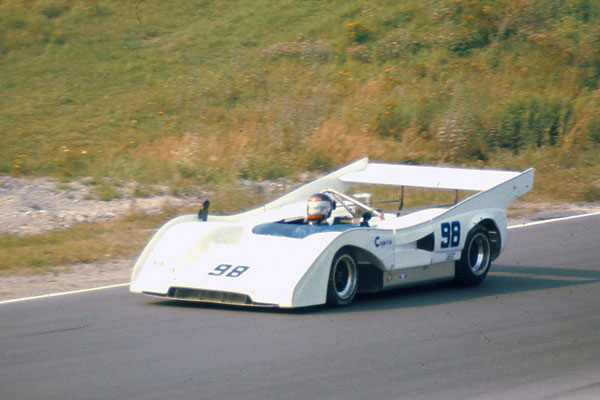 � � Charles Nearburg also drove the M8F for Carter Crompton on 7/24/1977, at the (single seat)� "Can-Am of Road America". By this time the car was equipped with a small block Chevy engine.� Although finishing five laps behind the leaders, Nearburg was credited with 11th place.� � Carter Crompton sold the M8F to Joel Finn. From Finn, ownership passed to Bill Wonder and� then to current owner Scott Hughes. � | ||||||
�
�
Except as otherwise credited, all photos shown here are from September 2010 when we viewed�
the car at The US Vintage Grand Prix at Watkins Glen. Photos by Curtis Jacobson�
for BritishRaceCar.com, copyright 2011. All rights reserved.�
�
All period photos of Commander Motor Homes racing team cars and personnel are from the�
personal collection of Bruce Robles and are used here by his express and exclusive�
permission. They have been substantively modified for BritishRaceCar.com website use.�
Copyright 2011. All rights reserved.�
�
All photos of the ex-Commander McLaren M8F racecar being driven by Charles Nearburg are from�
the personal collection of Wayne Ellwood through the assistance of Bob Lee, and are used here�
by their express and exclusive consent. They have been substantively modified for BritishRaceCar.com�
website use. Copyright 2011. All rights reserved.�
�
| If you liked this article, you'll probably also enjoy these: | �|||||
 | �
Tom Grudovich '60 Lola Mk.1 | �
 | �
Bill Thumel '67 Lola T70 Mk3 | �
 | �
Seb Coppola '71 Lola T192 | �
| You're invited to discuss anything you've seen here on The British Racecar Motorsports Forum! | �|||||
�
Notice: all the articles and almost all the photos on BritishRacecar.com are by Curtis Jacobson.
�
(Photos that aren't by Curtis are explicitly credited.) Reproduction without prior written permission is prohibited.
�
Contact us to purchase images or reproduction permission. Higher resolution images are optionally available.
�
